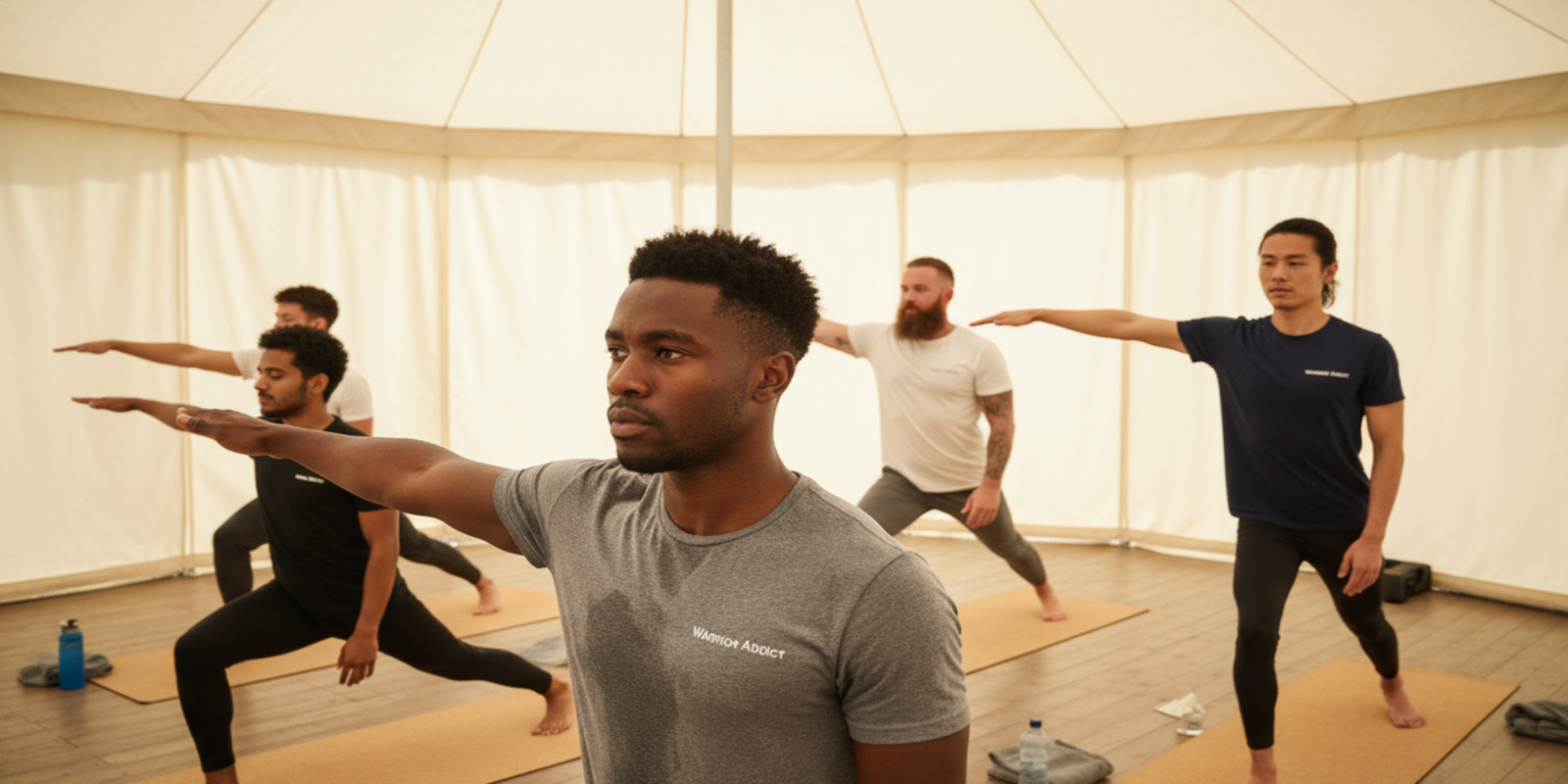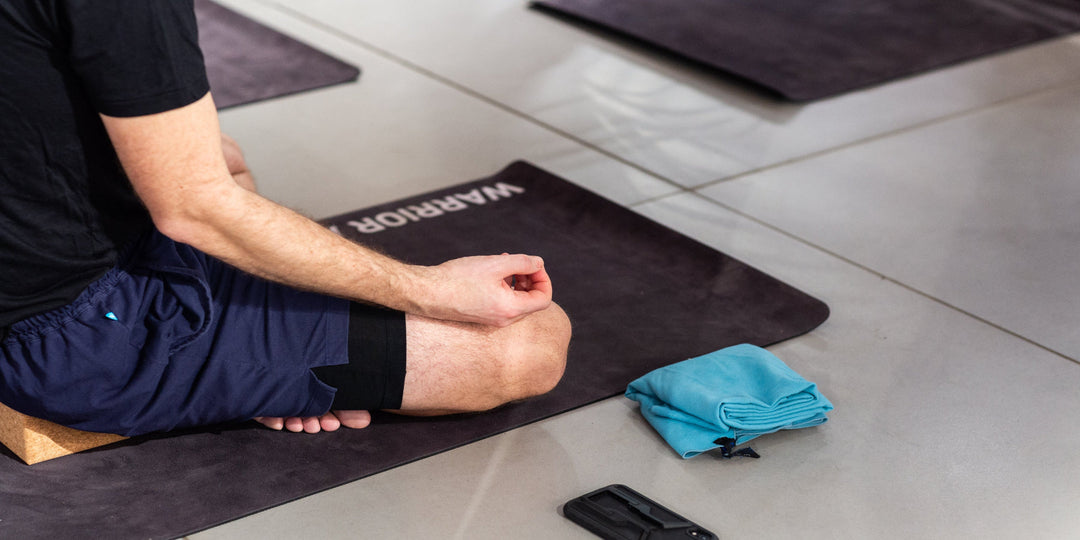Hot Yoga for Men: 10 Science-Backed Benefits & Getting Started

What Is Hot Yoga?
Hot yoga is a style of yoga practiced in a heated room, typically between 90-105°F (32-40°C) with humidity levels around 40%. The most well-known form is Bikram yoga, which follows a specific sequence of 26 postures and two breathing exercises in a room heated to 105°F. However, many studios now offer various hot yoga styles including heated vinyasa, power yoga, and yin yoga.
While yoga has traditionally been associated with women, an increasing number of men are discovering the powerful benefits of hot yoga for strength, flexibility, mental clarity, and overall athletic performance. The heated environment intensifies the practice, creating unique advantages that complement traditional strength training and cardiovascular exercise.

Essential Gear for Hot Yoga
Having the right gear makes all the difference in your hot yoga practice. Here are our top recommendations for men starting their hot yoga journey:
10 Science-Backed Benefits of Hot Yoga for Men
1. Increased Flexibility and Range of Motion
The heated environment allows muscles to warm up more quickly and stretch more deeply than in room-temperature yoga. For men who typically have tighter muscles from weight training or sports, this enhanced flexibility can significantly improve athletic performance and reduce injury risk.
Research published in the Journal of Strength and Conditioning Research found that regular yoga practice significantly improved flexibility in male athletes, with heated environments accelerating these gains. The heat allows connective tissue to become more pliable, enabling deeper stretches and improved range of motion in joints.
Reference: Journal of Strength and Conditioning Research
2. Enhanced Cardiovascular Health
Hot yoga provides a cardiovascular workout that rivals moderate-intensity exercise. The combination of heat and physical exertion elevates heart rate, improves circulation, and strengthens the cardiovascular system.
A study from the American Council on Exercise found that a single hot yoga session can burn between 330-460 calories while significantly elevating heart rate, making it an effective cardiovascular workout comparable to brisk walking.
Reference: American Council on Exercise
3. Improved Strength and Muscle Tone
Hot yoga builds functional strength through bodyweight resistance and isometric holds. Many poses require significant muscular engagement, particularly in the core, legs, and upper body. For men looking to complement their strength training, hot yoga provides a different stimulus that builds endurance and stabilizer muscle strength.
The practice emphasizes holding challenging positions, which builds muscular endurance and creates lean, functional muscle tone rather than bulk.

4. Stress Reduction and Mental Clarity
The combination of physical challenge, breath work, and mindfulness in hot yoga creates powerful stress-relief benefits. The intense focus required during practice helps quiet mental chatter and promotes a meditative state.
Research from Harvard Medical School indicates that yoga practices, including hot yoga, can reduce cortisol levels (the stress hormone) and activate the parasympathetic nervous system, promoting relaxation and recovery.
Reference: Harvard Health Publishing
5. Enhanced Athletic Performance
Many professional athletes incorporate hot yoga into their training regimens. The practice improves flexibility, balance, body awareness, and mental focus – all crucial components of athletic performance.
NBA players, NFL athletes, and professional runners have credited hot yoga with improving their game performance, reducing injuries, and extending their careers. The practice helps correct muscle imbalances, improve proprioception, and enhance recovery between intense training sessions.
6. Detoxification Through Sweating
While the body naturally detoxifies through the liver and kidneys, sweating in hot yoga can help eliminate certain toxins through the skin. The profuse sweating experienced during hot yoga may help remove heavy metals and environmental toxins.
Though more research is needed, studies suggest that sweat can contain trace amounts of BPA, heavy metals, and other environmental contaminants, making hot yoga's sweating component a potential complementary detoxification method.
7. Better Sleep Quality
The physical exertion and stress relief provided by hot yoga can significantly improve sleep quality. The practice helps regulate circadian rhythms and promotes deeper, more restorative sleep.
Research published in the Journal of Alternative and Complementary Medicine found that regular yoga practitioners reported better sleep quality, faster sleep onset, and fewer sleep disturbances compared to non-practitioners.
Reference: Journal of Alternative and Complementary Medicine
8. Injury Prevention and Recovery
Hot yoga's emphasis on flexibility, balance, and body awareness helps prevent common athletic injuries. The practice strengthens stabilizer muscles, improves joint mobility, and corrects muscular imbalances that can lead to injury.
For men recovering from injuries, hot yoga provides a low-impact way to maintain fitness while rehabilitating. The heat can help reduce muscle soreness and accelerate recovery from intense workouts.
9. Improved Focus and Mental Discipline
The challenging nature of hot yoga – maintaining difficult poses in intense heat – builds mental toughness and discipline that transfers to other areas of life. The practice requires sustained concentration, breath control, and the ability to remain calm under physical stress.
This mental training can improve performance in business, sports, and personal challenges by developing resilience and the ability to stay focused under pressure.
10. Weight Management and Metabolism Boost
Hot yoga can support weight management goals through calorie burning, increased metabolism, and improved body composition. The combination of cardiovascular work, strength building, and the metabolic demands of temperature regulation creates an effective fat-burning environment.
Regular practice can help build lean muscle mass, which increases resting metabolic rate, making it easier to maintain a healthy weight long-term.

Hot Yoga vs. Regular Yoga: What's the Difference?
Temperature and Humidity
- Hot Yoga: 90-105°F with 40% humidity
- Regular Yoga: Room temperature (68-72°F)
Intensity
- Hot Yoga: Higher cardiovascular demand, more sweating, increased calorie burn
- Regular Yoga: Focus on alignment, breath, and mindfulness without heat stress
Flexibility Gains
- Hot Yoga: Faster flexibility improvements due to warmed muscles
- Regular Yoga: Gradual flexibility development with lower injury risk
Hydration Needs
- Hot Yoga: Requires significant hydration before, during, and after
- Regular Yoga: Standard hydration needs
Getting Started: Hot Yoga for Beginners
What to Expect in Your First Class
Your first hot yoga class will be challenging. The heat takes adjustment, and you may feel lightheaded or need to take breaks. This is completely normal. Here's what to expect:
- Intense sweating – You'll sweat more than you've ever sweat before
- Elevated heart rate – The heat increases cardiovascular demand
- Mental challenge – Staying focused in the heat requires discipline
- Possible dizziness – Take breaks as needed and don't push too hard
- Deep stretching – Warmed muscles allow for deeper poses
What to Wear for Hot Yoga
Choosing the right clothing is crucial for hot yoga comfort and performance:
- Moisture-wicking shorts like our Bodhi Shorts (avoid cotton)
- Breathable, fitted top or go shirtless
- Quality athletic wear that won't become heavy when soaked
- Lightweight, stretchy fabrics that move with you
What to Bring
- Large water bottle (at least 32 oz)
- Yoga mat (or rent from studio)
- Large towel for your mat
- Small towel for wiping sweat
- Change of clothes
- Electrolyte drink for after class
Hydration Strategy
Proper hydration is crucial for hot yoga:
- Before class: Drink 16-20 oz of water 2 hours before
- During class: Sip water as needed, don't chug
- After class: Drink 20-24 oz of water with electrolytes
- Throughout the day: Maintain consistent hydration
Safety Tips for Men New to Hot Yoga
- Start slow – Don't try to match experienced practitioners
- Listen to your body – Take breaks when needed
- Don't eat heavily before class – Light meal 2-3 hours prior
- Arrive early – Acclimate to the heat before class starts
- Focus on breath – Proper breathing helps regulate body temperature
- Don't lock joints – Keep a micro-bend in knees and elbows
- Inform instructor of injuries – Get modifications as needed
Common Mistakes Men Make in Hot Yoga
1. Pushing Too Hard Too Soon
Many men approach hot yoga with the same competitive mindset they bring to the gym. This can lead to overexertion, dizziness, or injury. Hot yoga requires patience and gradual progression.
2. Inadequate Hydration
Underestimating hydration needs is a common mistake. You'll lose significant fluids through sweat, requiring more water than you might expect.
3. Wearing the Wrong Clothes
Cotton clothing becomes heavy and uncomfortable when soaked. Invest in moisture-wicking athletic wear designed for intense sweating.
4. Skipping the Warm-Up
Even though the room is hot, your muscles still need proper warm-up. Don't skip the beginning poses or rush through them.
5. Comparing Yourself to Others
Everyone's flexibility and strength levels are different. Focus on your own practice rather than comparing yourself to others in the room.
How Often Should Men Practice Hot Yoga?
For Beginners
Frequency: 1-2 times per week
Why: Allows body to adapt to heat stress while building foundational strength and flexibility
For Intermediate Practitioners
Frequency: 2-4 times per week
Why: Maintains progress while allowing recovery time for other training
For Advanced Practitioners
Frequency: 4-6 times per week
Why: Maximizes benefits while still allowing adequate recovery
Combining with Other Training
Hot yoga complements other forms of exercise:
- With strength training: Practice on non-lifting days or after lifting
- With running: Use as active recovery or cross-training
- With sports: Incorporate 1-2 sessions weekly for flexibility and recovery
Hot Yoga Styles for Men
Bikram Yoga
The original hot yoga, featuring 26 poses in 105°F heat. Structured and predictable, good for beginners who like routine.
Hot Vinyasa
Flowing sequences in heated rooms (90-100°F). More dynamic and varied than Bikram, appeals to athletes.
Hot Power Yoga
Strength-focused practice in heat. Builds muscle while improving flexibility, popular with men who lift weights.
Hot Yin Yoga
Longer-held passive poses in moderate heat. Excellent for deep stretching and recovery.
🧘♂️ Complete Your Yoga Setup
Quality gear enhances every aspect of your practice. From performance wear to premium yoga mats, invest in equipment that supports your journey.
Nutrition for Hot Yoga
Pre-Class Nutrition
- 2-3 hours before: Light meal with complex carbs and protein
- 1 hour before: Small snack if needed (banana, handful of nuts)
- 30 minutes before: Nothing – empty stomach is best
Post-Class Nutrition
- Immediately after: Electrolyte drink or coconut water
- Within 30 minutes: Protein shake or light snack
- Within 2 hours: Balanced meal with protein, carbs, and healthy fats
Electrolyte Replacement
Heavy sweating depletes electrolytes. Replenish with:
- Coconut water
- Electrolyte drinks (low sugar)
- Mineral-rich foods (bananas, avocados, leafy greens)
- Sea salt in water
Frequently Asked Questions
Q: Is hot yoga safe for men with heart conditions?
A: Men with cardiovascular conditions should consult their doctor before starting hot yoga. The heat significantly increases cardiovascular demand, which may not be appropriate for everyone. If cleared by your doctor, start slowly and monitor how you feel closely.
Q: Will hot yoga help me build muscle?
A: Hot yoga builds lean, functional muscle through bodyweight resistance and isometric holds, but it won't build bulk like weight training. It's excellent for developing core strength, stabilizer muscles, and muscular endurance. Many men combine hot yoga with strength training for optimal results.
Q: How much weight will I lose doing hot yoga?
A: Weight loss depends on many factors including diet, frequency of practice, and overall activity level. Hot yoga can burn 330-460 calories per session and may boost metabolism. However, most weight lost immediately after class is water weight that returns with rehydration. Consistent practice combined with proper nutrition supports sustainable weight management.
Q: Can hot yoga replace my cardio workouts?
A: Hot yoga provides moderate cardiovascular benefits and can supplement cardio training, but it shouldn't completely replace dedicated cardiovascular exercise like running or cycling. It's best used as part of a well-rounded fitness program that includes strength training, cardio, and flexibility work.
Q: Why do I feel dizzy during hot yoga?
A: Dizziness in hot yoga can result from dehydration, low blood sugar, breathing too rapidly, or standing up too quickly. Ensure proper hydration before class, don't practice on an empty stomach, focus on steady breathing, and move slowly between poses. If dizziness persists, take a break in child's pose or leave the room to cool down.
Q: Is it normal to feel nauseous after hot yoga?
A: Mild nausea can occur, especially when starting out, due to the heat, exertion, or eating too close to class. It usually improves as your body adapts. Prevent nausea by staying hydrated, avoiding heavy meals 2-3 hours before class, and not pushing too hard initially. If nausea is severe or persistent, consult a doctor.
Q: Should I practice hot yoga if I'm sore from weight training?
A: Yes, hot yoga can be excellent for recovery from weight training. The heat helps reduce muscle soreness, improve circulation, and promote recovery. However, listen to your body – if you're extremely sore or fatigued, opt for a gentler class or take a rest day.
Q: How long does it take to see results from hot yoga?
A: Most men notice improved flexibility and reduced stress within 2-3 weeks of consistent practice (2-3 times per week). Strength gains and body composition changes typically become noticeable after 4-6 weeks. Cardiovascular improvements and significant flexibility gains may take 2-3 months of regular practice.
Q: Can I do hot yoga every day?
A: While some people practice daily, most men benefit from 3-5 sessions per week with rest days for recovery. Daily practice is possible once you're well-adapted, but ensure adequate hydration, nutrition, and listen to your body. Overtraining can lead to fatigue, dehydration, or injury.
Q: What's the difference between hot yoga and Bikram yoga?
A: Bikram yoga is a specific type of hot yoga created by Bikram Choudhury, featuring a set sequence of 26 poses and 2 breathing exercises in 105°F heat. Hot yoga is a broader term encompassing any yoga style practiced in heated rooms (typically 90-105°F), including hot vinyasa, hot power yoga, and others with varying sequences and temperatures.
Conclusion: Is Hot Yoga Right for You?
Hot yoga offers powerful benefits for men seeking to improve flexibility, build functional strength, reduce stress, and enhance overall athletic performance. While challenging, especially at first, the practice provides unique advantages that complement traditional strength training and cardiovascular exercise.
The key to success with hot yoga is starting slowly, staying properly hydrated, listening to your body, and maintaining consistency. Whether you're an athlete looking to improve performance, a busy professional seeking stress relief, or someone wanting to build a more balanced fitness routine, hot yoga can be a valuable addition to your wellness regimen.
Remember that hot yoga is most effective as part of a comprehensive approach to health that includes proper nutrition, adequate sleep, and varied physical activity. Combined with quality athletic wear from our mens running shorts collection, you'll have everything you need to perform at your best in any activity.
Give hot yoga a try – your body and mind will thank you.
References
This article references research and information from the following sources:











Leave a comment